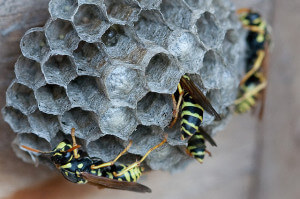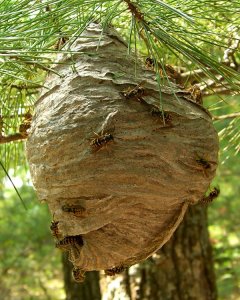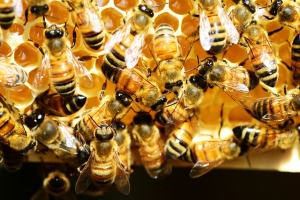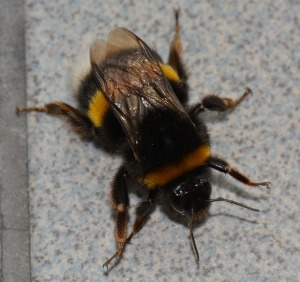Bees & Wasps
Bee & Wasp Removal Made Easy.
Paper Wasps, Hornets and Yellowjackets belong to the family Vespidae. They are all considered social wasps, meaning they develop colonies.
Wasps can become a problem when they decide to build their nest on, or near a home, or near a high traffic area such as sidewalks and other areas where conflict with people and pets are inevitable.
Wasps:
Wasps differ from bees in that most feed their young on animal matter, such as other insects or particles of meat-not pollen. Wasps build their nests out of a paper like material called carton. Carton is a mixture of wood fibers and saliva secretions from the female wasps. Wasp colonies usually only survive one season because the colonies mated queen is the only one who survives the winter. She survives by hiding beneath bark, between rocks or other such crevices, it is then up to her to start the cycle all over again next season. The queen wasp will produce in the late fall, then overwinter in a suitable place. In the spring, she will start a new nest. She lays her eggs and tends to them until they are mature enough to then take care of her. Wasps can forage 1/4 to 1/2 mile away from their nest in search of carbohydrates and proteins.
Paper Wasps build very simple nests compared to Hornets or Yellowjackets. Paper Wasp nests consist of only one tier, or layer of cells. The size of their nest is rather small, rarely exceeding five to eight inches in diameter. These nests face downward and are not covered. It is typical to find Paper Wasp nests under the eaves of homes, under windows, or under a porch.
The Bald-Faced Hornet is a common wasp that is rather large in size. The majority of the wasp is black with whitish or yellowish coloring around its head and the rest of its body. These wasps can be aggressive when agitated or threatened. Their nests can be as large as a basketball, but resemble a teardrop shape, and grey in color. The nests consist of several tiers of carton cells with a thin carton exterior surrounding them with a single opening at the bottom. Usually the nests can be found hanging from trees, or other tall standing structures.
YellowJackets:
Yellowjackets are some of the most common of wasps and are also the smallest of the Vespidae family. Yellowjackets can build their nests above ground, but they are more commonly found underground. Their nests resemble closely to that of the hornets nest, both in size and color. Yellowjackets behavior with humans is very unpredictable, which makes them very dangerous. Often times they ignore a passer by, other times they sting without warning.
Bees
Honey Bees are very beneficial insects to the environment because they pollinate flowering pants and produce honey. They are typically peaceful and non-aggressive if left alone. Their color varies from yellow to brown/black and orange. Honey Bees’ nests are made of beeswax that the worker bees secrete, unlike wasps who’s nests are made of the paper like secretion called carton. Individual colonies can range in numbers from 20,000 to 50,000 bees.
Bumble Bees are large and black with whitish, or yellowish coloring. Bumble Bees are social insects, that more often than not, nest in the ground. Much like the Honey Bee, Bumble Bees mean humans no harm, unless disturbed or threatened. They can, and will sting, only as a defensive reaction. Generally, Bumble Bees are no cause for concern, unless a nest in located in, or very near a home.
No matter the species, you don't want these creatures flying around your home or office. Call the best exterminators in Portland & Beaverton, OR today for bee & wasp removal.
Request a Quote

Service Area
We make sure the job is handled right, the first time. We mainly focus on Portland and Beaverton, OR, but we’re happy to travel areas such as Cedar Hills, Cedar Mill, Aloha, Tigard, Tualatin, Lake Oswego, Milwaukie, Sherwood, Oak Grove, Hillsboro, Cornelius, West Linn, Gladstone, Wilsonville, Newberg, Canby, Oregon City, Silverton and Salem. Give us a call. Chances are that we can make it to that area!




